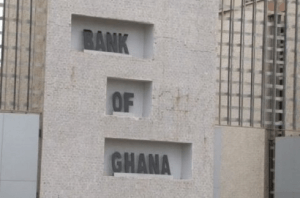Ghana banking industry exhibits positive outlook – Central Bank
 Dr Henry Kofi Wampah, Governor of the Bank of Ghana (BoG), on Wednesday said the banking industry ended 2014 on a firm note, with industry fundamentals exhibiting a positive outlook.
Dr Henry Kofi Wampah, Governor of the Bank of Ghana (BoG), on Wednesday said the banking industry ended 2014 on a firm note, with industry fundamentals exhibiting a positive outlook.
He observed that while concentration levels improved with the top five banks dropping significant market shares, domestic banks continued to account for the highest number of branches.
He said total assets of the industry increased by 42.2 per cent year-on-year to GH¢51.4 billion in December 2014 compared to a growth of 32.8 per cent in December 2013. Of the total assets, gross advances constituted 46.8 per cent compared with 47.1 per cent a year earlier.
Dr Wampah, who stated this in Accra during the Bank’s Monetary Policy Committee press briefing, said evidence from the Bank’s survey of credit conditions continued to point to easing of credit to both enterprises and households.
He said Small and Medium Enterprises’ (SMEs) access to credit and loans for mortgages were tightened marginally, declaring that, however, access to credit for large enterprises’ remained eased.
Dr Wampah said broad money (M2+) grew by 36.8 per cent year-on-year at the end of December 2014 to GH¢ 36.8 billion, compared with a growth of 19.1 per cent in the corresponding period last year.
He said this was driven largely by developments in the net domestic assets of the banking sector, on account of strong growth in domestic credit particularly to the energy sector.
The Governor said reserve money also expanded by 30.1 per cent in December 2014 compared to 15.1 per cent in the corresponding period last year, largely driven by significant increases in the cedi equivalent of the net foreign assets of the central bank.
He said in nominal terms, credit to the private sector grew by 42.1 per cent in December 2014, compared to 28.6 per cent in the same period last year.
The Governor said real credit growth was 21.9 per cent compared to 13.3 per cent a year earlier.
He said the credit growth was mainly funded by increased mobilisation of domestic deposits by the banking system.
Dr Wampah said the non-performing loans (NPL) ratio of the banking system, adjusted for fully provisioned loans, increased to 5.6 per cent at the end of December 2014 compared with 4.6 percent in the corresponding period in 2013.
He said, however, the unadjusted NPL ratio declined to 11.3 per cent from 12 per cent in 2013.
Dr Wampah said the capital adequacy ratio for the banking industry fell marginally to 17.9 per cent in December 2014 from 18.5 per cent in December 2013, but remained well above the prudential limit of 10 per cent.
He said interest rates generally trended up on the money market during the year
The Governor said the rate on the 91-day instrument increased to 25.8 per cent from 19.2 per cent.
He observed that similarly, the rate on the 182-day instrument increased to 26.4 per cent from 18.7 per cent.
He said the rate on the one-year note rose to 22.5 per cent from 17 per cent, and the two-year rate increased to 23 per cent from 16.8 per cent.
He said the three-year bond rate rose to 25.5 per cent from 19.2 per cent.
Dr Wampah noted that the weighted average interbank rate increased to 23.7 per cent from 16.3 per cent in December 2013.
He said average lending rates of the banks rose to 29 per cent from 25.6 per cent in December 2013.
He said the average rate on three-month term deposits increased to 13.9 per cent from 12.5 per cent.
Dr Wampah announced that Professor Joshua Yindenaba Abor, Dean of the University of Ghana Business School, is now a member of the BoG Monetary Policy Committee.
Source: GNA
